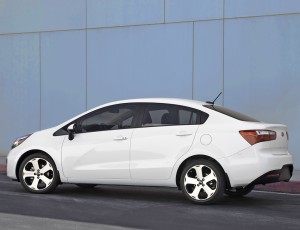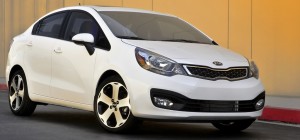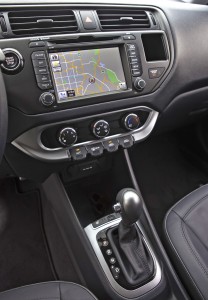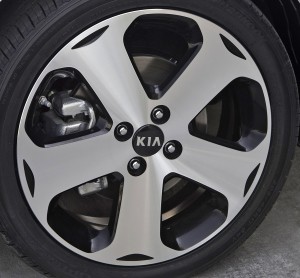It’s good to be Kia right now. Kia and its sister company, Hyundai, have received a lot of attention lately for groundbreaking styling along with class-leading fuel economy in some segments.
In fact, we’ve often said in this space that once the Koreans figure out the black art of proper suspension tuning, the pair could rule the automotive world.
Well, with this little Rio subcompact, it would appear that Kia has come to grips with finer points of ride and handling development.
So, does that mean the little Rio is ready for world dominance? Let’s find out.
As it did before, the Rio comes in two flavors: four-door sedan and five-door hatchback. Like just about every other Kia and Hyundai, the new Rio replaces a rather forgettable little car that got the job done, but was less than exciting.
The new car looks like a three-quarter scale Optima, which is a good thing. Still, it isn’t a complete copy of the bigger car. Best of all, the sedan version doesn’t look like an afterthought compared to the hatchback.
Kia also smartly priced the two versions. While some automakers price the hatchback significantly higher than the hatch version of cars that offer both, the difference is just $200 the Rio. Including destination, the sedan opens at $14,350, while the hatchback starts at $14,550.
The Rio SX sedan tested here, starts at $18,450 and comes with a sport-tuned suspension, 17-inch alloy wheels, soft-touch dashboard, Kia’s voice-recognition system called UVO and a variety of other upgrades. Add in a $2,200 premium package (navigation, leather seats, heated front seats, and a power sunroof) and $95 carpeted floor mats and you arrive at the Rio’s $20,545 sticker.
As is typical for Kias, there’s a lot of features for the money. Throwing in Kia’s 10-year/100,000-mile powertrain warranty and five years and 60,000 miles of roadside assistance sweetens the deal.
The Rio is surprisingly roomy. In front, there’s good space, including sufficient elbow room, which is important in this class. The back seats are even more roomy. In many cars this size, rear-seaters sit with their knees crammed against the seatbacks, but not in the Rio. There’s even decent headroom. There could be a little more toe-wiggling room in back, but that’s a quibble. With the Rio, you might not be laughed out of the carpool for buying a subcompact.
The expansive space continues in the trunk, which sports 13.6 cubic feet, which qualifies as big in this class.
The interior design is understated. It’s not near as expressive as a Chevrolet Sonic or Ford Fiesta, but it’s not boring either. It would seem that a car with a name like Rio, and in a class of cars targeted at young people, wouldn’t have such a serious interior.
The steeply raked windshield makes ingress a little difficult for taller folks. Headroom up front is OK with the premium pack’s sunroof.
A six-speed manual transmission is standard on the base LX while a six-speed automatic adds $1,100. The automatic is standard on the up-level EX and SX. The automatic never brought attention to itself. It offers manual shifting with the gear lever, but it automatically upshifts if you cross 6,000 rpm.
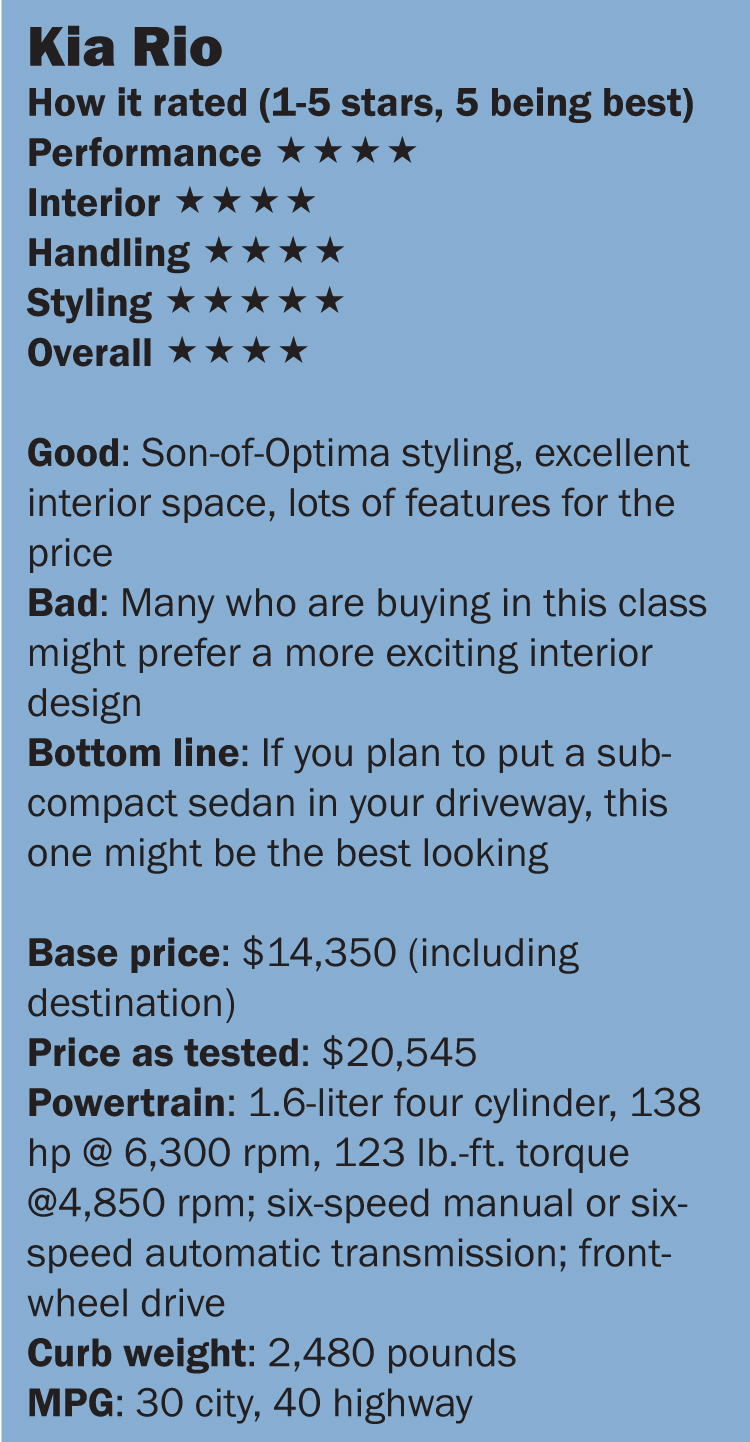 Fuel mileage is pretty much the same manual or automatic. It’s rated at 30 city and 40 highway for the automatic. For the manual, the city figure rises to 31, but the highway number stays at the magic 40. We saw 34 in a mix of rural two lanes and freeways. As is the case with almost every new model it brings out, the Rio uses direct fuel injection to maximize fuel mileage. A Ford Fiesta sips a little bit less than the Rio.
Fuel mileage is pretty much the same manual or automatic. It’s rated at 30 city and 40 highway for the automatic. For the manual, the city figure rises to 31, but the highway number stays at the magic 40. We saw 34 in a mix of rural two lanes and freeways. As is the case with almost every new model it brings out, the Rio uses direct fuel injection to maximize fuel mileage. A Ford Fiesta sips a little bit less than the Rio.
The 138-horsepower 1.6-liter four cylinder provides decent acceleration, although it gets a little wheezy during high-speed passing. In terms of noise, vibration and harshness, the Kia four is just midpack.
Now about that suspension tuning. While saying that the Rio has a sport-tuned suspension seems a bit of a stretch, it is finely developed. It handles turns well enough and the ride is very good for a car of this size. At last, one of the Koreans that isn’t taken down by poorly sorted ride and handling.
All of that being said, my co-pilot didn’t think very highly of it. The seatbelt latch pinched her hip, she found the head restraint uncomfortable and she thought there significant blindspots. Can’t please everyone.
Kia is on a role. It’s stylists keep hitting home runs, many models are near the top in fuel economy and it would appear, they’ve finally figured out the finer aspects of suspension tuning.

